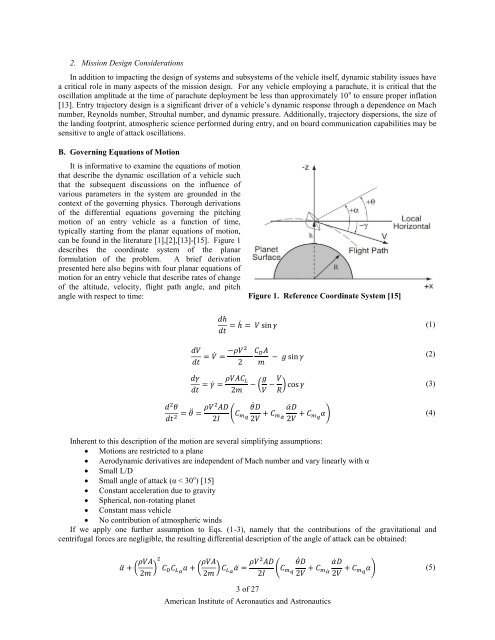Survey of Blunt Body Dynamic Stability in Supersonic Flow
Survey of Blunt Body Dynamic Stability in Supersonic Flow
Survey of Blunt Body Dynamic Stability in Supersonic Flow
You also want an ePaper? Increase the reach of your titles
YUMPU automatically turns print PDFs into web optimized ePapers that Google loves.
̇<br />
̇<br />
̇<br />
̇<br />
̇<br />
̇<br />
2. Mission Design Considerations<br />
In addition to impact<strong>in</strong>g the design <strong>of</strong> systems and subsystems <strong>of</strong> the vehicle itself, dynamic stability issues have<br />
a critical role <strong>in</strong> many aspects <strong>of</strong> the mission design. For any vehicle employ<strong>in</strong>g a parachute, it is critical that the<br />
oscillation amplitude at the time <strong>of</strong> parachute deployment be less than approximately 10 o to ensure proper <strong>in</strong>flation<br />
[13]. Entry trajectory design is a significant driver <strong>of</strong> a vehicle’s dynamic response through a dependence on Mach<br />
number, Reynolds number, Strouhal number, and dynamic pressure. Additionally, trajectory dispersions, the size <strong>of</strong><br />
the land<strong>in</strong>g footpr<strong>in</strong>t, atmospheric science performed dur<strong>in</strong>g entry, and on board communication capabilities may be<br />
sensitive to angle <strong>of</strong> attack oscillations.<br />
B. Govern<strong>in</strong>g Equations <strong>of</strong> Motion<br />
It is <strong>in</strong>formative to exam<strong>in</strong>e the equations <strong>of</strong> motion<br />
that describe the dynamic oscillation <strong>of</strong> a vehicle such<br />
that the subsequent discussions on the <strong>in</strong>fluence <strong>of</strong><br />
various parameters <strong>in</strong> the system are grounded <strong>in</strong> the<br />
context <strong>of</strong> the govern<strong>in</strong>g physics. Thorough derivations<br />
<strong>of</strong> the differential equations govern<strong>in</strong>g the pitch<strong>in</strong>g<br />
motion <strong>of</strong> an entry vehicle as a function <strong>of</strong> time,<br />
typically start<strong>in</strong>g from the planar equations <strong>of</strong> motion,<br />
can be found <strong>in</strong> the literature [1],[2],[13]-[15]. Figure 1<br />
describes the coord<strong>in</strong>ate system <strong>of</strong> the planar<br />
formulation <strong>of</strong> the problem. A brief derivation<br />
presented here also beg<strong>in</strong>s with four planar equations <strong>of</strong><br />
motion for an entry vehicle that describe rates <strong>of</strong> change<br />
<strong>of</strong> the altitude, velocity, flight path angle, and pitch<br />
angle with respect to time:<br />
Figure 1. Reference Coord<strong>in</strong>ate System [15]<br />
̇ (1)<br />
̇ (2)<br />
̇ ( ) (3)<br />
̈ (<br />
) (4)<br />
Inherent to this description <strong>of</strong> the motion are several simplify<strong>in</strong>g assumptions:<br />
Motions are restricted to a plane<br />
Aerodynamic derivatives are <strong>in</strong>dependent <strong>of</strong> Mach number and vary l<strong>in</strong>early with α<br />
Small L/D<br />
Small angle <strong>of</strong> attack (α < 30 o ) [15]<br />
Constant acceleration due to gravity<br />
Spherical, non-rotat<strong>in</strong>g planet<br />
Constant mass vehicle<br />
No contribution <strong>of</strong> atmospheric w<strong>in</strong>ds<br />
If we apply one further assumption to Eqs. (1-3), namely that the contributions <strong>of</strong> the gravitational and<br />
centrifugal forces are negligible, the result<strong>in</strong>g differential description <strong>of</strong> the angle <strong>of</strong> attack can be obta<strong>in</strong>ed:<br />
̈ ( ) ( ) ̇ (<br />
) (5)<br />
3 <strong>of</strong> 27<br />
American Institute <strong>of</strong> Aeronautics and Astronautics
















